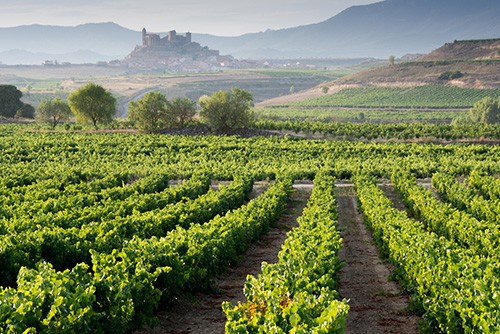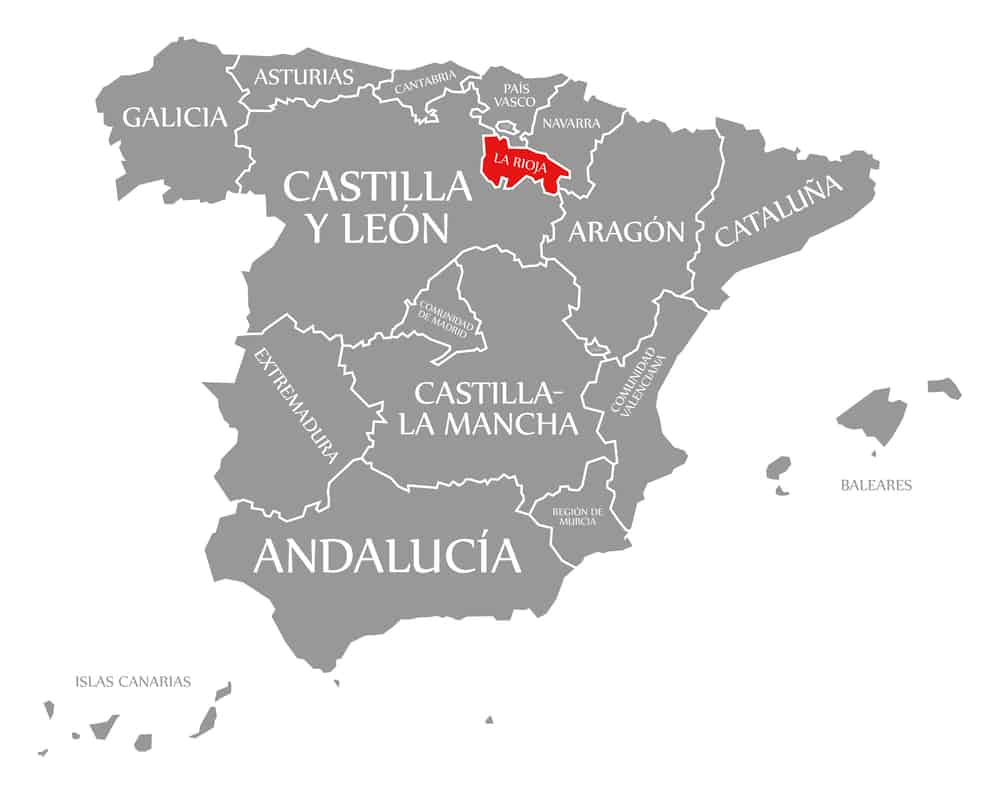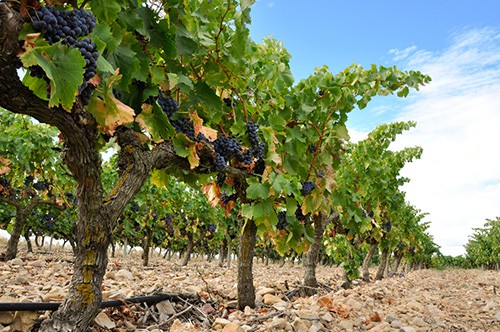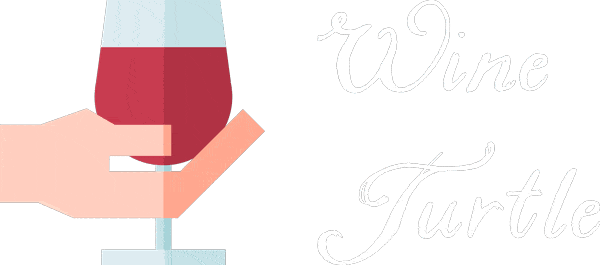Complete Guide to Rioja Wine | Wine 101

Rioja, more than a blend, is a region notorious for elegant and complex wines with rigorous aging requirements and a wealth of flavor profiles.
In this guide, we take a deep dive into one of Europe’s most notable wine regions. Discuss tasting notes, wine recommendations, plus a little terminology to make you look like a pro at the local wine shop!
Characteristics of Rioja Wine
Rioja is not a single wine, but a region known for producing exceptional red wines with extended aging and a variety of complex flavors.
Located in Northern Spain, this region stretches out 75 miles along both banks of the Ebro River and is largely shielded from the rough Atlantic breeze thanks to the small mountain ranges and outlying reaches of the Cantabrian Mountains.
Despite the common misconception that Spain produces warm, masculine wines, this region actually sits about 1,500 above sea level. This makes for a cooler climate that is able to extract nuanced, delicate flavors.
Now, we’ve already established at Rioja is not a wine - but if it were - that wine would be Tempranillo. Tempranillo is Spain’s pride and joy, as is evident by the Rioja blends we will discuss below.

La Rioja region highlighted on a map of Spain
Rioja Tasting Notes
Rioja grows about 90% red wines, which are composed predominantly of Tempranillo and other native varietals including Garnacha (Grenache), Mazuelo (Carignan), and Graciano, to name a few.
The flavor profile of a Rioja will vary significantly depending on the region it is grown, though the biggest difference between Rioja wines comes down to how long it is aged.
In general, you can expect a Rioja red blend to have complex flavors of earth and leather layered with dark fruit, tobacco, and plum. Rioja wines are high in tannins and have oak notes ranging from subtle to anything but.
How Rioja is Served
Red Rioja blends can be served at room temperature (60°-68°F) in a standard red wine glass.
While white Rioja blends are rare, there are some that are known for being light, crisp, and fresh. White Rioja blends are best served chilled at 49-55°F in a standard white wine glass.
Most Rioja red blends benefit from decanting for at least 30 minutes to 1 hour. Since the minimum requirement for aging Rioja reds is 2 years (with the longest aging wines waiting much, much longer before being released), decanting can wake up slumbering flavors and reveal plush fruit notes.

The History of Rioja
Spain first began establishing itself as a significant wine-growing region in the 1780s, when Spanish winemakers adopted the French practice of aging wines for extended periods of time in large oak casks.
Shortly after, winemakers began importing American oak and coopering it themselves (making the casks) as a way to cut costs. This practice remains to this day by many winemakers who prefer the flavor of American oak.
With the introduction of the phylloxera pest to France in the 1850s, many French winemakers relocated to Spain to make wine. This, combined with the improvements in Spain’s ability to export its wines, made Spain a formidable opponent to the major wine-growing regions of the time.
Unfortunately, the popularity of Spanish wines dwindled following the spread of phylloxera to Spanish vines, and French winemakers eventually relocated back to Spain.
Between the devastation caused by this insect, WWI, the Great Depression, and WWII, Spanish vines were either devastated or destroyed and replaced with wheat.
Thankfully, by the 1980s investors dedicated significant resources to re-establishing the Spanish wine country and replanted much of the destroyed vineyards. As you can probably guess, this paid off - and then some.



The Rioja Blend
Between tradition and innovation, Rioja blends now fall between two camps. On one side you have winemakers who prefer the traditional long-term aging in American oak.
These barrels are often neutral, meaning they impart little to no flavor and instead round out the intense flavors found in these wines. From there, you can expect a mellow wine with subtle vanilla, spice, and earth flavors.
The newer, more youthful winemakers are taking a slightly different approach, instead opting for new French oak and aging wines in a shorter period of time. These wines are richer in oak flavor, and from these, you can expect bold, spicy, extroverted wines.
Speaking of aging, it is essential to note that even the “shorter aged” wines of Rioja are still subject to some of the longest aging requirements of the Old World, with wines aging anywhere from 2-20 years being commonplace.
Spain’s Labeling Terms
As of the date of this posting, only Rioja and Priorat have been given the label designation of Denominación de Origen Calificada or DOCa.
This is the highest level of wine classification in Spain and indicates the wines from this region are “guaranteed” to be of superior quality.
As mentioned above, Spain places its labeling requirements based on the minimum amount of aging a wine must go through before being released.
Here’s a quick breakdown of the three different labels you might expect to find on a bottle of Rioja:
Crianza
These are your everyday drinkers which will come from good, but not exceptional vineyards. White wines are to be aged for a minimum of six months in oak. Red wines must be aged for at least two years, one year of which must be in oak.
Expect delicate flavors of vanilla, oak, and spice, with bright red fruit.
Reservas
These wines are from exceptional vineyards and are going to be more expensive, as they’re not guaranteed to be made every year. White wines are to be aged for two years, six months of which must be in oak. Red wines are to be aged for three years, at least one in oak.
Expect plush flavors of red fruit, plum, earth, and leather.
Gran Reservas
These wines are very rare, as they are only made by the most exceptional vineyards. White wines must be aged for four years, with at least one in oak. Red wines must be aged at least five years, with the first two years in barrels and the remaining three years in bottles.
Expect these wines to have a smooth, silky finish. They’re usually aged in neutral barrels and have a refined taste.
In addition to the labels above, there are also wines called joven, or sin crianza. These are usually not exported and are going to be drunk very young, with very simple flavors.
Notable Regions for Rioja Wine
Rioja can be broken down into 3 subregions, each with its own soil composition and varying levels of quality.
Rioja Alta
This is Rioja’s westernmost region and is home to some of the finest grapes and exceptional vineyards.
This is due to the cooler climate and higher elevation, placing these vineyards closer to the Atlantic and thus offering a cooling breeze.
In addition, the iron-rich clay mixed with limestone provides wines with depth and layers of intense flavor.
Rioja Alvesa
This region is similar to Rioja Alta in its elevation at proximity to the Atlantic, but these wines tend to be fuller in body and with greater acidity.
This subregion also has iron-rich clay mixed with limestone, which is nutrient poor and makes for low-yielding vines with concentrated flavor.
Rioja Oriental
Formerly known as Rioja Baja, this subregion is going to be warmer, lower elevation, and drier, making for wines that are higher in alcohol and lower in acidity.
Not surprisingly, you can also expect to find a fair share of Garnacha planted here, which craves the heat and makes for an excellent blending companion with Tempranillo.
The alluvial soil is fertile, standing in stark contrast to the nutrient-poor limestone farther up north.
Rioja Food Pairings
While a Rioja wine will vary between younger, lighter Crianzas and bigger, bolder Reservas, it is safe to expect wine from Rioja to have medium acidity, tannins, and a multitude of rich flavors. Therefore, these wines are best suited for richly flavored dishes and hearty proteins.
You can find many more amazing food pairings for Rioja in our guide to food pairings for the dominant grape, Tempranillo.
Awesome Rioja Blends to Try
Interested in getting specific? Here are some awesome expressions of all that Rioja has to offer.
Under $15 - Marques de Caceres Rioja Crianza 2017

Produced in the subregion Rioja Alta, this Crianza is as good today as it will be a year from now.
This wine is the perfect combination of toasted spice and plush red fruit, making for a great easy-drinking example with a smooth finish that’s unbeatable.
Under $30 - Marques de Murrieta Rioja Reserva 2017

This Rioja is made with a single grape, Tempranillo, and with it comes a host of signature flavors.
Red and black fruit, earth, toast, and tobacco are predominant in this wine, making for a perfect example of all that Rioja has to offer.
Under $100 - Bodegas Muga Gran Reserva Prado Enea 2014

Another awesome example of Rioja Alta, this Gran Reserva is deeply flavorful, with smooth tannins and a refined palate of dark red and black fruits, tobacco, and rich toast notes.
In addition to tasting exceptional, this winery also makes all their own oak casks using their in-house master cooper.
